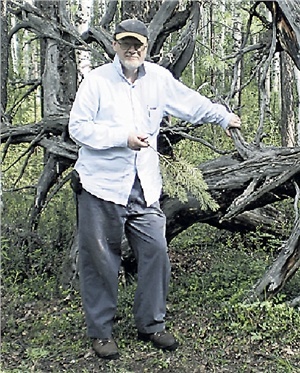Now, after many came together for conferences a century after the "Tunguska Event" in a Siberian Forest, the arguments continue.
On June 30, 1908, a blast, hundreds of times more powerful than the Hiroshima atomic bomb, destroyed about 2000sq km of forest but left no obvious crater.

|
| ©Illawarra Mercury News |
| Wollongong academic Ted Bryant at the Tunguska site. |
Ted Bryant, Associate Dean of the Science Faculty at the University of Wollongong, was one of a number of scientists from around the world to converge on the area in recent weeks. He took part in one of four conferences where scientists gave presentations.
There are 28 theories as to how the forest damage was caused, ranging from a giant UFO to an underground volcano detonated by a physicist harnessing electric charges in New York.
Professor Bryant is part of the largest group, who believe that a meteor exploded over the forest.
He stayed in Krasnoyarsk with colleagues from the Holocene Impact Working Group, a collective of scientists who believe meteorite impacts on Earth are more common than previously thought.
His group has discovered 15 possible ocean impact craters around the globe, many in shallow water, leading them to believe there are probably many more in deeper waters. The group also studies what it believes are land tsunami deposits from the impacts.
Prof Bryant says there is much passion in Russia, particularly, as scientists argue their cases over the Tunguska Event.
"There was funding from a billionaire worth about $140,000 for research arguing it was caused by a spacecraft," he said.
Prof Bryant travelled 30km into the impact zone by helicopter, camping in cabins built by the first scientists to venture there in 1928.
"Had it occurred over a city like Sydney, it would have destroyed the city," he said. "The picture with me in it shows the overturned roots of one of the trees blown down over 100 years ago.
"The (first scientists) found all the trees at this site were dead and standing up, because they were at the centre of the blast - very much like the building left standing beneath the epicentre of the Hiroshima atomic bomb blast.
"Trees were burnt on one side by radiation from the direction the meteorite entered the atmosphere. The following shock wave immediately extinguished any flames, leaving partially burnt trunks."
Some Russian scientists argue against a meteorite theory as there are no fragments and no crater.
And some scientists have been seeking what could be a small crater and deposits that did not break up in the atmosphere.



Reader Comments
to our Newsletter